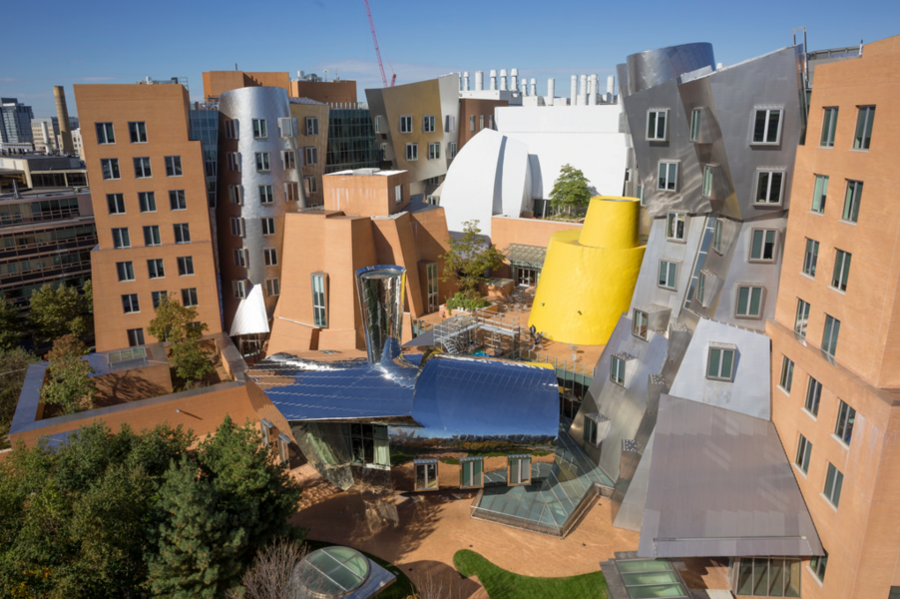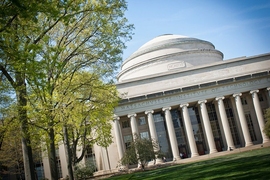How are instructors planning for remote learning in the fall? Why do on-campus students have to be on a meal plan? What will happen if there is a Covid-19 breakout in a residence hall? These and many other questions were on the minds of undergraduate students and their families at the Fall Reopening Virtual Town Hall sponsored by the Office of the Chancellor and the MIT Parents Association.
Thousands of participants tuned in on July 15 as 16 members of MIT’s administration and faculty fielded crowdsourced questions from the audience, along with several from student leaders. More than 600 questions were submitted during the 75-minute event, which was moderated by Matthew Bauer, senior director of communications in the Division of Student Life.
The forum fleshed out the plans described in the July 7 fall decision letter to the community from President L. Rafael Reif. Panelists also offered a window into how MIT arrived at its decisions and the core principles that were considered, such as protecting the community’s health, enabling students to stay on track to their degrees, and, as a matter of equity, giving every student the opportunity to spend at least one semester on campus.
Living on campus
Several panelists addressed what life will be like in the residences. Vice President and Dean for Student Life Suzy Nelson noted that several issues related to policies and community expectations were still being ironed out, such as the common space usage and guest policies. Judy Robinson, senior associate dean in the Residential Education Office, explained that the goal of the policies is to ensure “students have a real clear understanding of not just what the expectations are, but the responsibility to each other to minimize the spread of the virus.”
Professor of architecture and head of house for Baker House John Fernandez fielded a question about communal gathering. “We do know that there is the need for seeking out and developing alternative ways to socialize,” he said. To that end, a group of students, faculty, and staff are exploring ways to use outdoor spaces as much as possible and are developing a process to form self-organized social “pods” made up of small groups of residents in each house.
Students will play a vital role in ensuring these policies succeed, Fernandez noted — even simple gestures such as one student reminding another to wear a mask. “We can talk about compliance, and we can try to figure out ways to monitor student behavior, but what we’re most interested in is developing a new culture in which students are partnering with us and doing the right thing,” he said.
MIT is well-positioned for a potential Covid-19 breakout in the residence halls, Nelson said. There will be only one student per room, so students could effectively shelter in place, if needed. MIT Medical can provide increased testing, and there are isolation spaces available for students who test positive. “We certainly feel prepared, from full-scale breakout to a single case, and hopefully zero cases,” added Shawn Ferullo, associate medical director and chief of student health at MIT Medical.
Chancellor Cynthia Barnhart addressed one of the most upvoted topics: how the Institute is helping seniors who have signed off-campus leases but have decided to break them, to be able to live in MIT housing and access the campus. In addition to guidance about subletting, reassigning, or canceling a lease, MIT is offering a $5,000 Covid-era grant. “We knew that students and their families are facing new situations this year, situations that we couldn’t even begin to imagine,” she said. “And this is one of those situations where the additional grant that we’re providing will be able to provide families with some financial flexibility.” Barnhart suggested that students who need additional help reach out to staff in Student Support Services or Student Financial Services, who will work with them to address their concerns.
Following the town hall, the Division of Student Life launched the Student Housing Assistance Review Process (SHARP) on July 17. SHARP is designed to assist two categories of students: rising sophomores and juniors who wish to request on-campus housing during the fall 2020 semester; and students, including seniors, who are experiencing significant hardship and who believe they absolutely cannot live at home and cannot live on campus.
New ways of teaching and learning
The audience had several questions related to academics, including plans for remote instruction and experiential learning. “There’s a lot of work happening across MIT to make it a very rich remote and, for those on campus, in-person learning experience,” said Ian A. Waitz, vice chancellor for undergraduate and graduate education. He cited several examples: developing hands-on kits to send to remote students; shifting the timing of recitations to cover multiple time zones; making iPads available for teaching assistants and all undergraduates to replace “pencil and paper” work; implementing a new learning management system, called Canvas; and focusing on balancing synchronous and asynchronous teaching and learning.
In a similar vein, much effort has gone into ensuring that students can access hands-on learning experiences, explained Associate Dean of Engineering Peko Hosoi. “There are tremendous resources online now under Project Manus to help guide the students through making processes, understanding what tools are accessible, what kinds of tools can you use where, and how to get in touch with mentors.”
Fernandez reminded viewers that all undergraduates are eligible to pursue research, teaching, or service opportunities and earn a stipend of up to $1,900. “That will allow undergraduates to take full advantage of this new reality to do work, whether they’re on campus or remote, through programs such as UROP, UTOP, MISTI, PKG, Open Learning, and Sandbox. There are many people thinking about this, because it’s a very high priority for us to continue the ethos of making as part of learning.”
Welcoming MIT’s newest class
Several questions pertained to plans for first-year students, who will begin their MIT careers from home this fall. Concerns about forming connections with classmates, collaborating on schoolwork, and becoming part of the MIT community were addressed by Kate Weishaar ’18, project coordinator in the first-year experience program. “As anyone will tell you, the best part of MIT is the people, and we’re really trying to make sure that our first-year students see that, even if it is virtual.”
This summer, the Office of the First Year is offering orientation programming throughout the summer, a Slack channel, and small-group virtual gatherings. Many programs are in the works for the fall semester, Weishaar said, including expanding a successful mentoring pilot offered last spring in 8.02 (Electricity and Magnetism). She noted that more details about fall would be provided during the First-Year Town Hall on July 21.
Senior Associate Dean for Student Support and Wellbeing David Randall reassured first-years that MIT is committed to supporting them as they acclimate. “No matter how different it’s going to be in the fall, MIT is still going to be MIT … challenging, and rigorous, and sometimes overwhelming. Our amazing faculty are very aware of the challenges that students are facing and are being responsive. But we’ve got a whole team of support resources that remain available,” including advisors, Student Support Services, and Student Mental Health and Counseling at MIT Medical. “Right now, we’re thinking about all sorts of creative ways that we can allow students to easily ask for help online,” Randall added.
Dean for Admissions Stu Schmill offered guidance to incoming students weighing whether to take a gap year: consider your motivation for taking a gap year, and keep in mind that, although this won’t be a typical year at MIT, many gap year experiences are not available. Although each student should make the choice that is best for them, he said, “we’re working very hard to make the MIT experience continue to be special, continue to be something that’s in line with MIT’s mission, ‘mind and hand.’”
Striking the right balance
In addition to fielding specific questions, panelists had the opportunity to expand on the decision process and rationale behind MIT’s approach this year. “If you look at what’s happened over the last four months,” Barnhart said, “we have engaged across the Institute — faculty, students, staff, alumni — and we have had literally thousands of people involved. So the overall decision process is reflective of a lot of thought, it’s reflective of striking what we feel is the appropriate balance among the interests of the various stakeholders.”
MIT’s stance is intentionally conservative, Waitz said. “Our strategy is to start the fall in a way where we have a smaller number of students on campus, where they are all in our residential facilities, where we have the ability to do regular testing and really to learn what it takes to operate in the pandemic. The whole strategy is wrapped around this idea of succeeding in the fall — not being right on the edge where we may succeed or fail.”
This approach will allow MIT to adapt for the spring, whether Covid conditions improve or not. “We’ve thought a lot about this,” Barnhart said, noting that the default posture for spring is also conservative. There are two additional factors that may allow more students to return in the spring, though: new residence halls will be open by then, and MIT will have a better understanding about the disease and how to manage it within the community. However, Barnhart said, “we feel confident that if conditions do not get better, our spring plan can remain intact.”
Many of the panelists mentioned the integral role students have played on various task forces, working groups, and other teams as MIT has wrestled with difficult — and sometimes unpopular — decisions impacting every aspect of their education. Hosoi said that students have been deeply involved in housing policy discussions and, as a case in point, shared what she called a “very MIT” story.
“I was asked to take a look at ventilation in houses and probabilities of infections in different spaces. I’ve now handed that off to a team of students to do all those calculations for all of the dorms. I have to say, I teach fluid mechanics, and I have never had students more interested in ventilation than they are right now! So I think the partnership with students is really important in this.”









